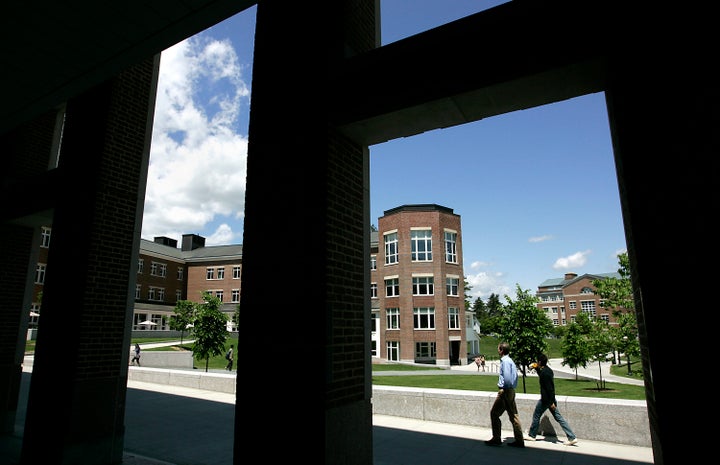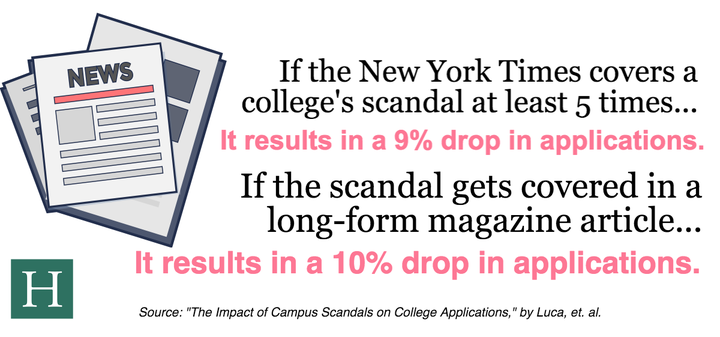
Scandals can cost universities thousands of applicants, but exactly how many interested students a school loses may depend on how widely the incident is covered in the media, according to a new working paper from Harvard Business School.
The analysis discovered that a school should prepare for a steep drop in applicants if it’s involved in a scandal that ends up being detailed in a lengthy magazine article or covered by The New York Times.
The paper singles out the hazing scandal at Dartmouth College, which was widely featured in newspaper articles and detailed in an extensive Rolling Stone article in 2012. Andrew Lohse, a former member of the Sigma Alpha Epsilon fraternity, publicly spoke about hazing and drinking practices that he said went unchecked for years. Dartmouth has since launched numerous reforms attempting to address the issues.
The negative publicity, however, seemed to hurt the school’s applications.
Dartmouth revealed in February 2014 that it had seen a 14 percent drop in applications, which many people attributed to protests over harassment, sexual assault and hazing on campus. Ivy League competitor Harvard University saw a 2.1 percent drop in applicants over the same period.
“Drinking and abuse are problems that all colleges think about, and it is not clear that Dartmouth’s case is any better or worse ― it is simply the one that became most public,” wrote the paper’s authors, Michael Luca and Patrick Rooney, both of Harvard Business School, and Jonathan Smith of the College Board.
Their new report shows that media coverage made all the difference when it came to how many people applied to schools, specifically at a time when sexual assault on campuses was gaining widespread media attention and many universities were being scrutinized for potentially mishandling rape cases.
The new research suggests that if a scandal was mentioned in The New York Times at least five times, the school received around a 9 percent drop in applications the following year. A scandal covered in a long-form article was linked to about a 10 percent drop in the number of applications a school received ― or, as the paper’s authors put it, “roughly the same impact on applications as a 10-ranking drop in the influential U.S. News and World Report College Rankings.”

“One of the challenges of the study is that we cannot disentangle whether the impact of a scandal on college applications was because of the incident itself or the surrounding media attention ― they go hand-in-hand,” Smith, of the College Board, told The Huffington Post.
For a comparison, we can look at schools that were caught up in scandals but not covered by the Times or magazines.
For example, the University of Southern California received national and local attention in 2013, when several women complained that the school had mishandled their sexual assault cases. Activists raised similar concerns at the University of California, Berkeley in 2013 and 2014.
But neither scandal was covered in lengthy magazine articles, nor reported on by The New York Times. Admissions data reviewed by HuffPost indicates that both schools saw an increase in their applications around this time: USC’s application numbers went up by 4,000 between 2013 and 2014, while UC Berkeley’s applications climbed by 11,000 from 2013 to 2015.
Harvard Business School looked at 124 public scandals involving cheating, hazing, sexual assault and murder at the nation’s top 100 universities, as ranked by U.S. News & World Report.
The study’s authors used a Google search of media content published online to collect information on scandal coverage between 2001 and 2013. Of course, the media and news landscape were very different in 2001 and 2013, but Smith said a separate study would be needed to look at the role of social media on these scandals.
The Times didn’t cover 83 of the scandals, and mentioned just 13 of them more than five times. The Times typically only covered a scandal after a local outlet or a magazine had scooped it, the report notes. Nine of the scandals were covered in long-form articles in Rolling Stone, National Catholic Register, The New Yorker, New York Magazine, The New York Times, Sports Illustrated, People Magazine or Vanity Fair.
The new paper, however, notes a couple of positive takeaways. Schools are far less likely to have a scandal in the year after one occurs, because they are on heightened alert or implementing reforms, so the campus could actually be safer.
Because of this, the study’s authors do not blame the media for drawing more attention to scandals or harming a school’s reputation. “Our finding suggests that media is serving the purpose of holding colleges accountable by deterring future scandals,” they write.
Plus, it’s potentially easier to get accepted to a university that’s receiving fewer applications.
_______
Tyler Kingkade is a national reporter covering higher education and sexual violence. You can reach him at tyler.kingkade@huffingtonpost.com, or find him on Twitter: @tylerkingkade.
